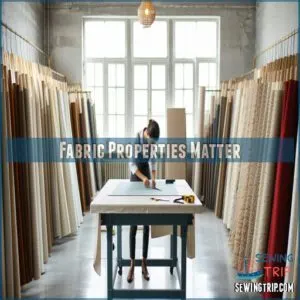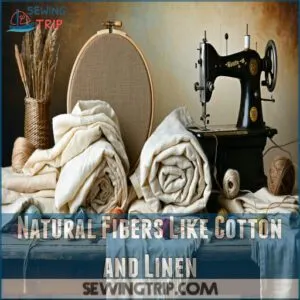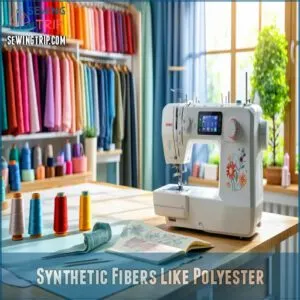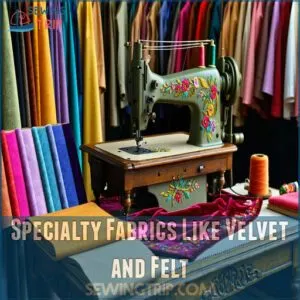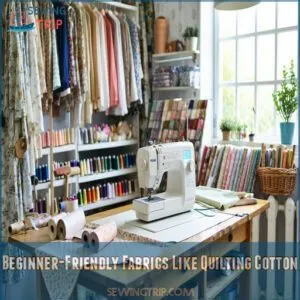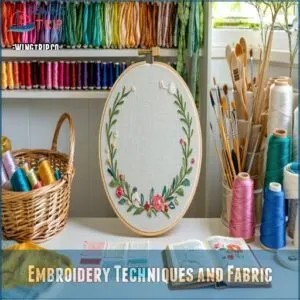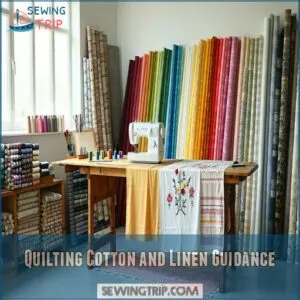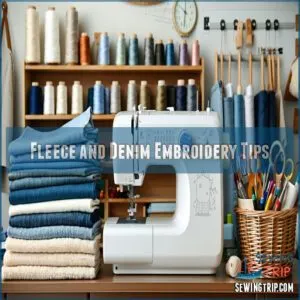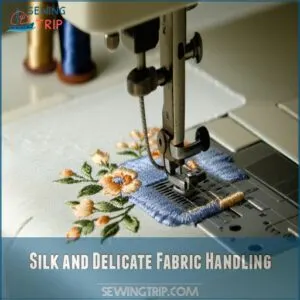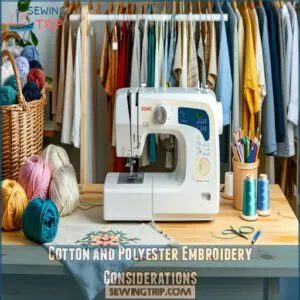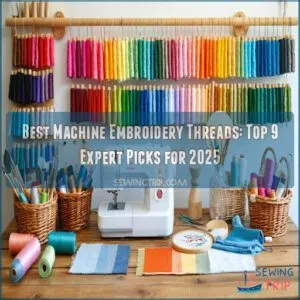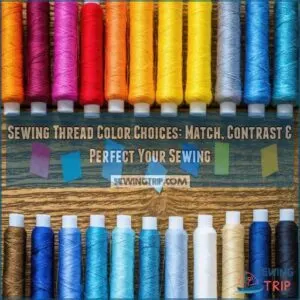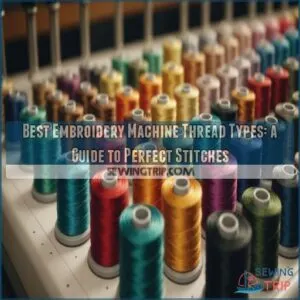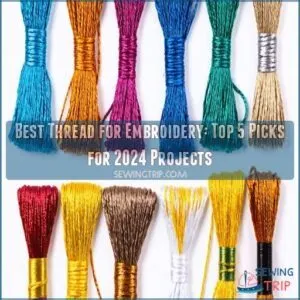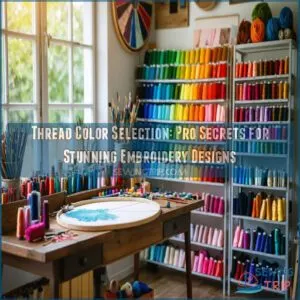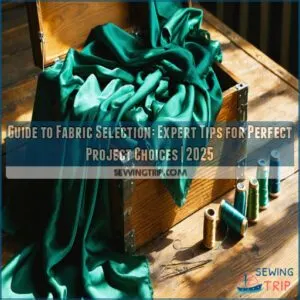This site is supported by our readers. We may earn a commission, at no cost to you, if you purchase through links.
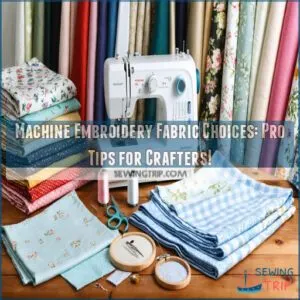
Cotton and linen are your trusty sidekicks for beginners, offering stable surfaces that’ll make your designs sing.
Polyester blends bring durability and smooth surfaces perfect for crisp stitches.
Consider your fabric’s thread count, weave density, and elasticity – they’re the secret sauce to preventing design disasters.
Lightweight fabrics with tight weaves are your golden ticket, while specialty materials like velvet demand special attention.
Pro tip: your needle and stabilizer selection can make or break your embroidery game, turning potential fabric fails into stunning masterpieces.
Table Of Contents
Key Takeaways
- You’ll want to choose fabrics with a tight weave and stable structure, like quilting cotton or polyester blends, to ensure your embroidery design stays crisp and doesn’t distort during stitching.
- You’ll need to match your stabilizer, needle type, and thread selection to your fabric’s specific properties, considering factors like weight, stretch, and texture to prevent puckering and achieve professional results.
- You’ll discover that different fabrics demand unique embroidery techniques, so you’ll need to adjust your approach – from using gentle methods on delicate silks to more robust techniques on denim or fleece.
- You’ll find that understanding fabric composition isn’t just technical knowledge – it’s the secret to transforming your machine embroidery from good to extraordinary, making each project a personalized masterpiece.
Fabric Properties Matter
When you’re diving into machine embroidery, understanding your fabric’s properties isn’t just technical know-how—it’s the secret sauce that’ll make or break your crafting success.
You’ll want to pay close attention to characteristics like thread count, weave density, and elasticity, as these factors directly impact how your beautiful embroidery design will look and last.
Fabric Composition and Density
Always check your fabric’s composition before diving into an embroidery project.
Your material’s density and fiber content play a huge role in design success.
Think of fabric thickness like a canvas – some are delicate watercolors, others bold oil paintings.
Heavier materials with tight weave patterns provide a sturdy foundation, while lightweight fabrics demand extra care and precision.
Understanding the right embroidery fabric choices is essential for achieving the desired outcome in your embroidery projects, considering the fabric thickness.
Thread Count and Weave Importance
Unraveling the secrets of thread count and weave can make or break your embroidery project.
Your fabric’s structural DNA determines its performance.
Consider these key points:
- Tight weaves prevent thread slippage
- Higher thread counts boost needle penetration
- Weave density impacts design suitability
- Fabric structure affects overall embroidery stability
Understanding the importance of thread selection basics is essential for achieving superior embroidery results.
Master your fabric’s characteristics, and you’ll create embroidery that truly stands out, leveraging thread selection and fabric structure to enhance your work.
Elasticity and Shrinkage Considerations
After sorting through thread count mysteries, let’s tackle fabric’s elastic personality. Your embroidery success hinges on understanding how fabrics stretch and shrink.
Embroidery doesn’t shrink fabric itself, but distortion mimics shrinkage due to push and pull forces during stitching. distortion mimics shrinkage
| Fabric Type | Stretch Behavior | Shrinkage Risk |
|---|---|---|
| Knits | High Elasticity | Significant |
| Wovens | Low Elasticity | Moderate |
| Synthetics | Minimal Stretch | Low |
Check out this quick guide to material stability. Master fabric recovery to prevent design disasters!
Colorfastness and Texture Impact
During embroidery, color bleeding and wash fastness can make or break your project’s visual appeal.
Your fabric’s texture dramatically influences how designs pop and hold up over time.
Pay attention to surface feel – smooth silks showcase delicate work, while textured linens add depth.
Test fabrics beforehand to prevent unexpected color shifts or design distortions.
Suitable Fabrics for Embroidery
When you’re undertaking a machine embroidery project, choosing the right fabric can make or break your design’s success.
You’ll want to examine factors like fabric weight, weave, and fiber type to guarantee your embroidery appears professional and stands up to wear and tear, considering aspects that impact the overall quality, such as how these elements contribute to a professional look.
Natural Fibers Like Cotton and Linen
When fabric density speaks, cotton and linen answer.
These natural fiber champions offer rock-solid performance for machine embroidery.
Cotton’s smooth surface welcomes simple designs, while linen’s tight weave provides durability that’ll make your artwork pop.
The choice of cotton embroidery fabric is vital for achieving desired texture and appearance.
Explore quilting cotton for beginner projects or explore linen’s unique natural textures.
Synthetic Fibers Like Polyester
Stepping from cotton’s natural charm, polyester blends offer a game-changing synthetic twist for machine embroidery.
These resilient synthetic fibers boast impressive durability and a smooth surface perfect for crisp designs.
Opt for lightweight polyester fabrics with tight weaves, choosing sharp needles and polyester threads to maximize your textile science success.
Specialty Fabrics Like Velvet and Felt
Explore the domain of specialty fabrics like velvet and felt, where texture meets technique in machine embroidery.
These unique materials demand special attention, but don’t worry – we’re here to support you.
- Embrace the luxurious velvet pile
- Master felt’s dense, forgiving surface
- Conquer needle selection challenges
- Discover stabilizer secrets
- Create stunning, professional-looking designs
Carefully choose your approach, and you’ll transform these tricky fabrics into embroidery masterpieces.
Understanding various fabric types for sewing is essential to making informed decisions about the materials you use in your projects.
Beginner-Friendly Fabrics Like Quilting Cotton
Most crafters swear by quilting cotton for machine embroidery beginners.
Its stable weave and medium weight make it a dream for simple stitch patterns and embroidery tools.
Pre-wash your cotton to prevent shrinkage, choose light designs, and you’ll nail those beginner projects with confidence.
Stick to 100% cotton for best results.
Embroidery Techniques and Fabric
You’ll want to choose your embroidery fabric with precision, as each fabric’s unique properties can make or break your creative project.
Understanding how different embroidery techniques interact with various fabric types will help you achieve professional-looking results that showcase your crafting skills.
Applique and Chenille Techniques
If you’ve conquered basic embroidery, applique and chenille techniques will be your next adventure.
Master fabric cutting and precise thread tension to layer embroidery designs seamlessly.
Chenille stitches create textured, dimensional effects that’ll make your machine embroidery pop.
Experiment with different applique methods to transform simple fabrics into stunning, multi-layered masterpieces that showcase your creativity.
Sequin and Beading Methods
After mastering applique, you’ll find sequin and beading methods add serious sparkle to your embroidery game.
Here’s how to nail those eye-catching embellishments:
- Select razor-sharp needles for precise sequin placement
- Choose lightweight adhesive for secure bead attachment
- Match thread color to your sequin or bead palette
- Practice tension control on scrap fabric first
Embroidery isn’t just stitching—it’s wearable art that turns heads, making embroidery game a notable aspect of this creative process.
Stitch Density and Fabric Compatibility
After sparkling up your project with sequins, you’ll want to nail stitch density.
Different fabrics demand unique approaches.
Fabric tension, thread weight, and needle penetration directly impact embroidery stability.
Lightweight quilting cotton handles tight stitches beautifully, while knits and fleece require looser, more forgiving stitch patterns.
Understanding embroidery fabric choices is vital for achieving the best results.
Choose wisely to prevent fabric distortion and maintain impeccable stitch quality.
Fabric Prone to Puckering and Distortion
Fabric puckers like a wrinkled shirt left too long in the dryer, testing even seasoned embroiderers’ patience.
Your embroidery can fight back against distortion by:
- Stabilizing thin, stretchy materials with appropriate backings
- Minimizing fabric movement during hooping
- Selecting needles that match fabric weight and delicacy
Careful fabric handling prevents unwanted ripples and preserves your creative vision.
Fabric Selection and Guidance
When choosing fabrics for machine embroidery, you’ll want to evaluate key properties like thread count, weave, and fabric stability that dramatically impact your project’s success.
Understanding how different materials respond to needle punching, stretching, and design complexity will help you select the perfect fabric for crisp, professional-looking embroidery results, which is crucial for achieving fabric stability.
Quilting Cotton and Linen Guidance
After exploring intricate embroidery techniques, let’s zoom in on quilting cotton and linen – your new best friends in machine embroidery.
These fabrics aren’t just materials; they’re canvases waiting to showcase your creativity.
Understanding their unique characteristics can transform your projects from good to extraordinary.
To achieve a harmonious design, consider color theory basics when selecting fabrics for your machine embroidery projects.
| Cotton Property | Linen Characteristic |
|---|---|
| High thread count | Tight, strong weave |
| Smooth surface | Natural texture |
| Minimal stretch | Lightweight body |
| Easy to stabilize | Exceptional durability |
| Beginner-friendly | Professional finish |
Fleece and Denim Embroidery Tips
Your denim and fleece embroidery dreams just got easier!
Dodge fabric frustrations by choosing the right needle—Organ Jersey for fleece’s delicate fibers and Chenille for denim’s tough texture.
Pro tip: use a walking foot to prevent stretching, and grab a topper like Sulky Solvy to keep stitches crisp and clean.
Stretch control is your secret weapon.
Silk and Delicate Fabric Handling
After mastering fleece and denim embroidery, silk becomes your elegant challenge.
Handle this luxurious fabric with kid gloves – sharp needles and lightweight stabilizers are your secret weapons.
Gentle touch is key for soft embroidery, choose simple, low-density designs that won’t overwhelm the delicate silk fabric.
Pre-wash carefully, use minimal tension, and let your creativity shine through whisper-soft stitches.
Cotton and Polyester Embroidery Considerations
After dancing with delicate silk, you’ll find cotton and polyester offer more forgiving embroidery experiences.
These fabric blends bring stability to your machine embroidery journey.
Consider these key points:
- Cotton fabric absorbs thread tension beautifully
- Polyester threads provide incredible embroidery durability
- Fabric blends balance stretch and structure
Master thread tension, and you’ll transform ordinary materials into extraordinary embroidered masterpieces.
Choosing The Right Fabric
When you’re ready to level up your machine embroidery game, choosing the right fabric isn’t just a detail—it’s your secret weapon for stunning projects.
From quilting cotton to silk, understanding your fabric’s unique properties will help you create eye-catching designs that’ll make seasoned crafters stop and stare.
Fabric Weight and Embroidery Design
Three key fabric weight factors can make or break your embroidery project.
Heavier materials like denim demand thicker needles and more punch, while lightweight fabrics like chiffon require delicate handling.
Your design’s density and thread weight must match the fabric’s characteristics to guarantee stunning, stable embroidery that looks professional and holds up over time, with a result that is truly stunning.
Stabilizer Selection and Fabric Stretch
After weighing fabric weight, you’ll want to tackle fabric stretch with the right stabilizer.
Your embroidery success hinges on smart stabilizer selection.
Here’s your fabric tension game plan:
- Cut-away for stretchy knits
- No-show mesh for lightweight fabrics
- Tear-away for stable woven materials
- Wash-away for sheer designs
Using the correct embroidery stabilizer is essential for preventing fabric distortion.
Prevent puckering and keep your design looking sharp.
Needle Selection and Hooping Methods
How critical is your needle choice in machine embroidery?
Selecting the right needle types guarantees crisp stitches and prevents fabric damage.
From flat-shank to ballpoint needles, your choice depends on fabric type and thread selection.
Match your machine settings carefully, considering eye size and point style.
Proper hooping maintains fabric tension, preventing puckering and guaranteeing professional embroidery results.
Project Size and Fabric Limitations
Your embroidery project’s fabric dreams might hit a snag when size enters the equation.
Managing machine embroidery fabric limitations requires strategic planning:
- Hoop size dictates design scale
- Fabric width impacts potential artwork
- Material properties restrict intricate details
Smart crafters understand fabric scaling isn’t just about dimensions—it’s about matching your creative vision with technical constraints.
Considering the fabric choice guidelines is essential to confirm a successful embroidery project.
Frequently Asked Questions (FAQs)
Is machine embroidery easier?
You’ll find machine embroidery easier with the right fabric, stabilizer, and technique.
Quilting cotton and fleece are beginner-friendly, while practicing on simple designs helps you master the craft without overwhelming yourself.
Which fabric is best for machine embroidery?
Just when you thought your hobby would hit a snag, quilting cotton swoops in as the hero.
It’s beginner-friendly, stable, and forgiving—perfect for crisp designs that’ll make your embroidery machine sing with precision and joy.
What are the different types of embroidery materials?
You’ll discover materials like cotton, silk, linen, fleece, denim, and polyester.
Each fabric brings unique textures and challenges, so you’ll want to match your needle, stabilizer, and technique to create stunning embroidered masterpieces, using the right approach for each type of fabric like polyester.
How do I choose the right fabric for my Embroidery Project?
You’ll want to match your fabric’s weight, weave, and stretch to your design complexity.
Consider cotton for beginners.
Choose stabilizers wisely.
Test your fabric before diving into your embroidery masterpiece.
What makes a good embroidery fabric?
Ironically, your dream embroidery isn’t about the fanciest fabric—it’s about understanding how thread dances with texture.
Choose stable, smooth fabrics like quilting cotton or linen that’ll showcase your design without fighting your every stitch.
How do I get Started with machine embroidery?
Grab a beginner-friendly machine, start with quilting cotton, and snag some simple designs.
Invest in stabilizers, sharp needles, and practice hooping.
Watch online tutorials, join embroidery groups, and don’t fear making mistakes – they’re part of learning.
What is the best fabric to machine embroidery on?
When your fabric whispers potential, quilting cotton becomes your embroidery soulmate. It’s beginner-friendly, stable, and forgiving—transforming rookie stitches into textile triumphs with minimal fuss.
What are the three types of fabric used in embroidery?
You’ll tackle embroidery with three key fabric types: cotton (a beginner’s best friend), linen (strong and lightweight), and polyester (durable and versatile).
Each fabric brings unique qualities to your stitching adventure.
What fabrics cannot be embroidered?
When threading the needle of possibility, you’ll want to steer clear of stretchy, slippery surfaces like silk chiffon, tulle, and netting.
These fabrics are embroidery’s Achilles’ heel, challenging even the most skilled crafters with their unpredictable behavior.
Can you machine embroider on any fabric?
You can’t embroider on every fabric, but most work with the right techniques.
Delicate, stretchy, or ultra-thin materials need special stabilizers and careful handling to prevent distortion and guarantee crisp, clean embroidery results.
Conclusion
As you master machine embroidery fabric choices, you’ll transform from novice to needle ninja.
Whether you’re stitching delicate silk or robust denim, your fabric selection defines your embroidery success.
Embrace the journey of understanding fabric properties, stabilizers, and techniques.
Your machine embroidery fabric choices will elevate your crafting from good to extraordinary, turning every project into a personalized masterpiece that showcases your creativity and technical skill.
- https://www.digitizingmadeeasy.com/main-machine-embroidery-fabrics/
- https://hatchembroidery.com/resources/blog/choosing-the-right-fabric-for-your-embroidery
- https://www.cre8iveskill.com/blog/top-ten-fabrics-for-machine-embroidery-designs
- https://www.reddit.com/r/Embroidery/comments/erokkr/best_fabric_to_embroider_on/
- https://www.toughkittencrafts.com/choosing-fabric-for-machine-embroidery/

